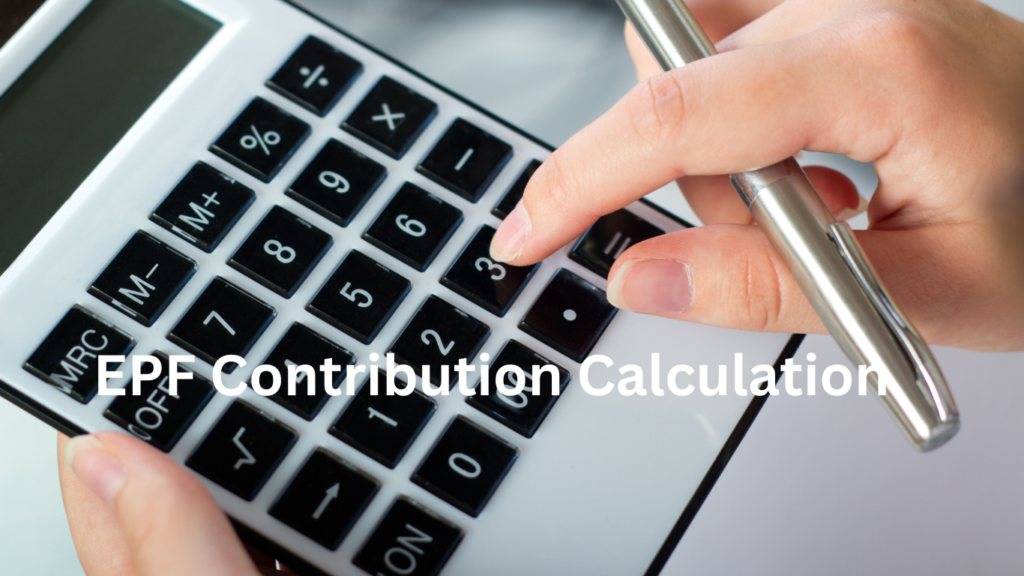Learn how the EPF Contribution Calculation works, including a detailed breakdown of employee and employer contributions, and a clear example to help you understand the process. This guide is your go-to resource for building financial security and planning for retirement.
In the Employees Provident Fund (EPF) system, both employees and employers contribute a portion of the employee’s monthly salary to help the employee save for the future. This is a detailed guide to EPF savings for retirement.

Why EPF Contributions Matter
- Retirement Security: EPF contributions act as a retirement fund, ensuring financial independence in later years.
- Tax Benefits: Both employees and employers enjoy tax advantages on EPF contributions, making it a financially smart choice.
- Liquidity: Employees can access a portion of their EPF savings in case of emergencies, such as medical needs or home loans.
Here’s how it works:
What is the EPF contribution ratio:
- Contributions:
Employee Contribution:
Employees contribute 12% of their monthly wages (Basic pay & DA) to the EPF. This is automatically deducted from their salary.
Employer Contribution:
The employer also contributes 12% of the employee’s monthly wages. However, this 12% is split into two parts:
EPF Contribution: 8.33% goes to the Employees’ Pension Scheme (EPS).
EPF Contribution: The remaining 3.67% goes to the EPF.
Total Contributions:
Employee: 12% of wages
Employer: 12% of wages (split into EPF and EPS)
Overall, they contribute 24% of the employee’s salary each month to the EPF system, which helps build a savings fund for the employee’s retirement and future needs.
Visit the official EPFO website for more details
Read This Also: Pension Calculation Using Table D
EPF Contribution Calculation Example Calculation
Here’s an example of how the EPFO contribution is calculated:
1. Employee Details:
Basic Pay: ₹12,000
Dearness Allowance (DA): ₹2,000
Total Wages: ₹12,000 + ₹2,000 = ₹14,000
Contribution Breakdown
2. Employee Contribution:
Employees are required to contribute 12% of their total wages to the EPF.
12% of ₹14,000 = ₹1,680
Thus, the Employee’s Contribution is ₹1,680.
3. Employer Contribution:
The employer’s contribution is divided into two parts:
1. Employee Provident Fund (EPF) Contribution: 3.67% of total wages
2. Employee Pension Scheme (EPS) Contribution: 8.33% of total wages
Employer’s Contribution Calculation:
EPF Contribution (3.67% of ₹14,000) = ₹513.8
EPS Contribution (8.33% of ₹14,000) = ₹1,166.2
Thus, the Total Employer Contribution is ₹513.8 (EPF) + ₹1,166.2 (EPS) = ₹1,680.
Final Total Savings in EPF
The final amount saved in the EPF account includes both the employee’s and employer’s contributions:
₹1,680 (Employee) + ₹513.8 (Employer-EPF) + ₹1,166.2 (Employer-EPS) = ₹3,360
In this example, the employee’s total savings in the EPF at the end of the month is ₹3,360.
Read This Also: How to know your UAN
Key Takeaways from the Example
Dual Contributions: The EPF system ensures that both employees and employers contribute equally to building the employee’s retirement savings.
EPS Benefit: A significant portion of the employer’s contribution goes into the pension scheme, ensuring long-term financial security for employees after retirement.
Growing Savings Corpus: The contributions from both parties add up significantly over time, providing a robust financial safety net.
The Employees’ Provident Fund (EPF) system is a cornerstone of financial security and retirement planning in India. With equal contributions from both employees and employers, the EPF provides a robust savings mechanism, tax benefits, and partial liquidity in times of need. Understanding how these EPF Contribution Calculation and how they benefit you can empower you to take charge of your financial future. Whether it’s for retirement or an unforeseen emergency, the EPF is a reliable tool for building financial stability over the long term.
FAQ: EPF Contribution Calculation
Q1. What is EPF, and why is it important?
The Employees’ Provident Fund (EPF) is a savings scheme designed to help employees build a retirement fund. It ensures financial security, provides tax benefits, and allows partial withdrawals during emergencies.
Q2. How much do employees contribute to the EPF?
Employees contribute 12% of their monthly wages (Basic Pay + Dearness Allowance) to the EPF.
Q3. How much do employers contribute to the EPF?
Employers also contribute 12% of the employee’s wages. This is split into:
- 3.67% to the EPF
- 8.33% to the Employee Pension Scheme (EPS)
Q4. What is the total contribution to an employee’s EPF account?
The combined contribution from the employee (12%) and employer (12%) totals 24% of the employee’s monthly wages.
Q5. Can I access my EPF savings before retirement?
Yes, partial withdrawals are allowed for emergencies such as medical needs, education, home loans, or marriage expenses.
Q6. What is the EPS, and how is it different from EPF?
The Employee Pension Scheme (EPS) is part of the employer’s contribution (8.33%), designed to provide a monthly pension after retirement.
Q7. How does the EPF help with retirement planning?
Over time, the contributions from both the employee and employer, along with accumulated interest, create a substantial savings corpus, ensuring financial stability post-retirement.
Q8. How can I calculate my EPF contributions?
Here’s a quick example:
- For total wages of ₹14,000, an employee contributes ₹1,680 (12%).
- The employer contributes ₹1,680, split into ₹513.8 (EPF) and ₹1,166.2 (EPS).
- Total monthly savings in the EPF account: ₹3,360.
The EPF is a valuable tool to secure your financial future—start managing your contributions effectively today!


